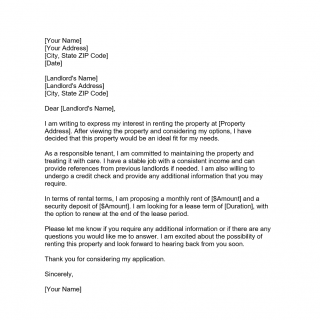Letter of Intent for Rent
A Letter of Intent for Rent is a document that outlines the intent of a prospective tenant to rent a property. This letter is generally written by the tenant and presented to the landlord or property owner as part of the rental application process. The purpose of the letter is to demonstrate the tenant's interest in renting the property and provide the landlord with some basic information about the tenant.
The Letter of Intent for Rent typically consists of several parts, including:
- Introduction: This section of the letter should introduce the tenant and provide some basic information about their background and why they are interested in renting the property.
- Rental Terms: This section of the letter should outline the proposed rental terms, including the monthly rent amount, security deposit, lease duration, and any other relevant details.
- Tenant Information: This section of the letter should provide some basic information about the tenant, such as their name, contact information, employment status, and credit history.
- Signature: The letter should be signed by the tenant to indicate their agreement with the terms outlined in the letter.
Important fields to consider when compiling a Letter of Intent for Rent include the proposed rental terms and tenant information. It is important to ensure that the proposed rental terms are reasonable and in line with the current rental market. Additionally, the tenant should provide accurate and up-to-date information about their background and financial situation.
Examples of when a Letter of Intent for Rent may be used include:
- When a tenant is interested in renting a property and wants to demonstrate their seriousness to the landlord.
- When a landlord requires a letter of intent as part of the rental application process.
Parties involved in a Letter of Intent for Rent include the prospective tenant and the landlord or property owner.
Letter of Intent for Rent sample
[Landlord's Name]
[Landlord's Address]
[City, State ZIP Code]Dear [Landlord's Name],
I am writing to express my interest in renting the property at [Property Address]. After viewing the property and considering my options, I have decided that this property would be an ideal fit for my needs.
As a responsible tenant, I am committed to maintaining the property and treating it with care. I have a stable job with a consistent income and can provide references from previous landlords if needed. I am also willing to undergo a credit check and provide any additional information that you may require.
In terms of rental terms, I am proposing a monthly rent of [$Amount] and a security deposit of [$Amount]. I am looking for a lease term of [Duration], with the option to renew at the end of the lease period.
Please let me know if you require any additional information or if there are any questions you would like me to answer. I am excited about the possibility of renting this property and look forward to hearing back from you soon.
Thank you for considering my application.
Sincerely,
[Your Name]
Benefits of using a Letter of Intent for Rent include:
- It helps to demonstrate the tenant's interest in the property and can increase their chances of being selected as a tenant.
- It provides the landlord with some basic information about the tenant, which can help them make an informed decision about whether or not to rent to the tenant.
Risks and problems that can arise when using a Letter of Intent for Rent include:
- The landlord may receive multiple letters of intent and may need to select one tenant over another, which can be a difficult decision.
- The tenant may change their mind about renting the property after submitting the letter of intent, which can be frustrating for the landlord.
Related forms to a Letter of Intent for Rent include a rental application, lease agreement, and security deposit agreement.
Differences between a Letter of Intent for Rent and other rental forms include:
- A Letter of Intent for Rent is typically used as a preliminary step in the rental application process, while a lease agreement is a legally binding contract that outlines the terms of the tenancy.
- A Letter of Intent for Rent is generally more informal than a lease agreement and may not include all of the details that are included in a lease agreement.
Once the Letter of Intent for Rent is submitted to the landlord or property owner, it can influence the future of the tenant by increasing their chances of being selected as a tenant. The form is typically submitted as part of the rental application process and is stored by the landlord or property owner for future reference.

